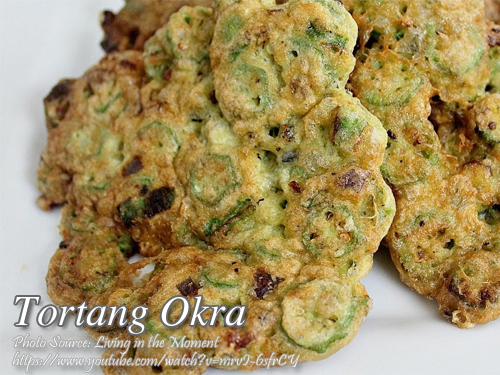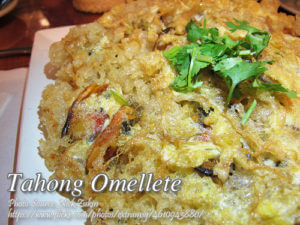This is a simple vegetable omelet dish made from okra, eggs, rice flour and spices. Actually the rice flour included in the ingredients can be omitted but it is also necessary if you want to add some slight crunchiness similar to making okoy. This is also a healthy alternative to pork giniling omelet but I think you can also add some sliced pre-cooked pork, chicken or shrimps together with the sliced okra.
Also, if you notice in the procedure on sautéing the okra first before combining with the rest of the ingredients, sautéing the okra will remove at least half of the sliminess. But if the natural texture of okra is okay with with you, the I think there is no need to pre-cook it.
Tortang Okra: A Simple but Special Dish from Home
There’s something about the simplicity of an omelet that always takes me back to my childhood. But when I first tried making it, it wasn’t just the taste that tugged at my heartstrings—it was the memory of family gatherings, of cooking in my Lola’s old kitchen, surrounded by the familiar smells of garlic and onions sizzling in the pan. Tortang okra is one of those dishes that brings back the warmth of home, and every bite feels like a taste of nostalgia.
I learned this recipe from my Tita Letty, who would make it every time we visited her in Laguna. She’d serve it as a side dish or as a main course on days when meat was scarce or simply unnecessary. She always told me that it was the perfect example of how Filipino cooking can turn the simplest ingredients into something special. “You don’t need much,” she said. “Just fresh okra, eggs, and some love in your cooking.”
A Healthier, Crunchier Alternative to Traditional Omelets
What makes okra omelet stand out isn’t just its simplicity; it’s the texture and flavor that come together in every bite. Okra, as we know, has a reputation for being slimy, but there’s a trick to avoid that, and I’ve stuck to it ever since Tita Letty taught me. The secret lies in a quick sauté. By sautéing the sliced okra for just a few minutes before mixing it with the eggs, you reduce a good amount of the sliminess that some people dislike. It’s a small step, but it makes a world of difference in texture.
And for those who love a little extra crunch, a bit of rice flour does wonders. It reminds me of how okoy, the Filipino shrimp fritter, gets its crispy edges. The flour isn’t necessary, but I love the way it adds a delightful contrast to the softness of the eggs and okra. This small addition elevates the dish, making it more than just your typical vegetable omelet.
Sautéing: The Key to Perfect Texture
When it comes to cooking okra, technique matters. I’ve seen my mom, my Tita Letty, and even my uncle Tito Boy argue over the best way to deal with okra’s naturally slimy texture. Some people embrace it, but others—like me—prefer to cut it down a bit. That’s why sautéing the okra first is essential. When you lightly sauté the okra in a bit of oil, it sears the edges and draws out some of that moisture. You’re left with tender okra that retains its flavor without becoming overly slimy, which makes for a much more pleasant eating experience, especially for those who aren’t used to the vegetable.
Once the okra has been sautéed, it’s mixed with beaten eggs and a variety of seasonings. Garlic powder, black pepper, and chili powder bring just the right amount of flavor to the dish, while onions and spring onions add a bit of sweetness and crunch. The combination of these ingredients, along with the slight crispiness from the rice flour, results in a dish that’s not only tasty but also hearty enough to stand on its own.
A Versatile Recipe with Endless Possibilities
While this dish is often seen as a healthier alternative to the classic pork giniling omelet, there’s no reason you can’t mix things up. I’ve had versions of tortang okra that include bits of pre-cooked chicken, shrimp, or even pork. My cousin Marlon swears by adding shrimp for a more seafood-forward flavor, especially when he’s trying to impress guests. The beauty of this recipe is that it’s adaptable. You can keep it simple, with just okra and eggs, or add in whatever leftover proteins you have in the fridge.
In fact, I remember one summer when my sister came back from a trip to Bicol with fresh seafood. She decided to throw some of the small prawns into our usual okra omelet, and it instantly became a family favorite. The sweetness of the prawns complemented the earthiness of the okra, creating a balance of flavors that we still talk about during family reunions.
A Dish with Roots in Filipino Culture
Tortang okra may not have the same recognition as other Filipino classics like adobo or sinigang, but it’s a dish that speaks to the heart of our cuisine—simple, resourceful, and full of flavor. In many rural areas, where meat is less accessible, vegetables like okra are staples. Families use what’s available, and they create dishes that are not only filling but also packed with nutrients. Okra, for instance, is rich in fiber, vitamins, and antioxidants, making it a great addition to anyone’s diet.
And yet, despite its humble ingredients, this dish has the power to evoke memories of home, of shared meals with loved ones. In my family, it has become more than just a recipe—it’s a tradition. Every time I cook it, I think of Tita Letty and the lessons she passed down to me in her little kitchen in Laguna. It’s a reminder that the best dishes aren’t always the fanciest or the most complicated. Sometimes, all you need is a little love, a few simple ingredients, and a willingness to savor every bite.
So the next time you’re looking for a quick, easy, and healthy meal, give this okra omelet a try. It might just become a new family favorite, passed down from one generation to the next.
How to Cook Tortang Okra
Ingredients
- 2 cups okra sliced thinly
- 3 Tbsp. red onion minced
- 2 pcs raw eggs
- 3 Tbsp. spring onion
- 1 tsp garlic powder
- 1/2 tsp ground black pepper
- 1 tsp fine salt
- 1/8 tsp chili powder optional
- 1/4 cup rice flour
- 1/4 cup cooking oil
Instructions
How to cook tortang okra:
- Heat a non-stick pan with a little oil and saute the okra until all the sides are seared for about 2 minutes to reduce the slimy texture. Remove from the pan and set aside.
- In a mixing bowl, beat the eggs and add the okra, onion, spring onion, garlic powder, black pepper, salt, chili powder and rice flour. Mix until all the ingredients are well combined.
- Heat oil in a frying pan and put about one and a half tablespoon of the okra mixture and form into a round or circular patties. Make 2 to 3 patties per batch but avoid sticking the edges to each other.
- Fry 3 to 4 minutes on one side then flip to cook the other side for another 3 to 4 minutes. After cooking remove from the pan and drain in paper towels or colander to drain excess oil. Repeat the same process on the rest of the okra mixture. Serve hot.
Notes
Cooking Tips:
Sauté Okra to Reduce Sliminess
Pre-cooking the okra by sautéing it for a few minutes helps reduce its natural sliminess. This step is essential if you prefer a smoother texture in your omelet. By searing the okra, you also lock in its flavor while keeping it tender.Add Rice Flour for a Crispy Texture
Incorporating a small amount of rice flour into the mixture gives your omelet a satisfying crunch, similar to that of okoy. The flour creates a light crispy coating as it fries, which contrasts beautifully with the soft egg and okra. If you prefer a healthier option, you can omit the flour, but it definitely adds a delicious twist.Don’t Overcrowd the Pan When Frying
When frying the patties, avoid overcrowding the pan to ensure each one cooks evenly. This allows heat to circulate properly, giving the patties a nice, golden-brown crust on the outside while remaining fluffy inside. Overcrowding can lead to steaming, which prevents them from crisping up perfectly.





